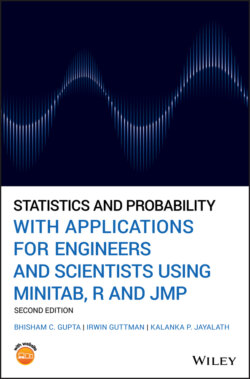Читать книгу Statistics and Probability with Applications for Engineers and Scientists Using MINITAB, R and JMP - Bhisham C. Gupta, Irwin Guttman - Страница 128
3.7 Introducing Random Variables
ОглавлениеSuppose that a finite sample space S consists of m elements . There are possible events that can be formed from these elements, provided that the empty event and the entire sample space S are counted as two of the events. This is revealed by the fact that we have the choice of selecting or not selecting each of the m elements in making up an event. Rarely, if ever, is one interested in all these events and their probabilities. Rather, the interest lies in a relatively small number of events produced by specified values of some function defined over the elements of a sample space. For instance, in the sample space S of the possible hands of 13 bridge cards, we are usually interested in events such as getting two aces, or eight spades, or 10 honor cards, and so on.
A real and single‐valued function defined on each element e in the sample space S is called a random variable. Suppose that can take on the values . Let be the events that are mutually exclusive and exhaustive in the sample space S, for which , respectively. Let . Then, we say that is a random variable defined over the sample space S and is a discrete random variable which takes the values with the probabilities , respectively. Since are disjoint and their union is equal to the entire sample space S, we have
(3.7.1)
We can arrange the values of and the corresponding probabilities in table form as follows:
(3.7.2)
The values of the discrete random variable together with their associated probabilities are called the discrete distribution of . The function , defined by
(3.7.3)
is called the probability function (p.f.) of . Ordinarily, we drop the e and refer to the random variable as X. The set of possible values is called the sample space of the random variable X.
Example 3.7.1 (Defining concept of the probability function) Let X be a random variable denoting the sum of the number of dots that appear when two dice are thrown. If each of the 36 elements in the sample space is assigned the same probability, namely , then , the probability function of X, is as follows:
| 2 | 3 | 4 | 5 | 6 | 7 | 8 | 9 | 10 | 11 | 12 | |
| 1/36 | 2/36 | 3/36 | 4/36 | 5/36 | 6/36 | 5/36 | 4/36 | 3/36 | 2/36 | 1/36 |
If the sample space S has an infinite number of elements and if the random variable x can take on a countably infinite set of values we have a discrete random variable with sample space {}.
Example 3.7.2 (Probability function for an event to occur) Let X be a random variable denoting the number of times a die is thrown until an ace appears. The sample space of X is and the probability function is given by the table:
| 1 | 2 | ||||
| 1/6 |
since
Note that the probability function must possess the following properties.
If any one of these properties does not hold, then is not a probability function.
We conclude this section with the comment that in this section, we have discussed only discrete random variables. There is indeed another type of random variables, called continuous random variables, discussed extensively in Chapter 5. Suffice it to say here that a continuous random variable may take all values in at least one interval, and it, of course, contains an infinite number of values that are not countable. This is in contrast with a discrete random variable, which takes values that are countable, as discussed here and in Chapter 4.
